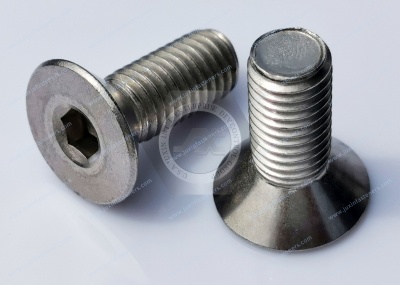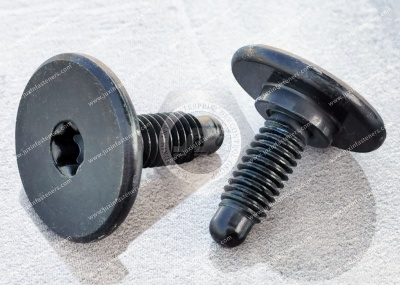Call Us
+86 136 6007 9809
Call Us
+86 136 6007 9809
Jul. 09, 2024
Flat Head Screws (Hex Drive Flat Head Screws, Phillips Flat Head Screws)
Screws used in construction sites and other projects, Hex Drive Flat Head Screws are screws that are primarily used in construction sites and other projects. It is characterized in that the screw body is formed with axially extending screw threads on the axial surface and is provided with at least one cut groove at the end portion thereof.
Flat head screws, which have a screw body, the screw body of the axial surface formed with axially extending screw threads, and at least one cut groove in its tail end, the cut groove above the groove mouth and then to the center of the screw body dug to set up a chip removal groove, the chip removal groove deep in the interior of the screw body and beyond the center line of a predetermined angle, to provide to avoid the role of the chip blocking the cut groove mouth. They are primarily used in construction sites, hydroelectric power station power systems, and other fields.
Difference between flat head screws and countersunk head screws
Flat head screws: the axial surface of the screw body is formed with the axial extension of the screw thread, with at least one cut groove at the end. In the slotted mouth to the center of the screw, dig a chip slot; the chip slot goes deep into the body of the screw and beyond the center line of a predetermined angle; the leading role is to avoid cutting chips blocking the slotted mouth.
Countersunk head screws: screw the head into a 90-degree cone, the head of the tool to tighten the groove, a slot, a cross slot, a hexagonal slot, a plum groove, and so on.


Flat head screws and countersunk head screws difference:
1. Different contact surfaces, flat head screws, and workpiece contact surface for the bit plane, while the countersunk head screws are bit cone;
2. Different forces, flat head screws are more force, while the countersunk head screws are less force;
3. Different combinations, flat head screws can be used in combination with this flat gasket, while the countersunk head screws can only be used in combination with the gasket with a taper;
4. Different ways of use, flat head screws can be deep inside the countersunk hole and can also be exposed to the outside, but countersunk head screws are generally only inside the countersunk head hole.
Processing
Annealing
Purpose: Heat the wire to the appropriate temperature, keep it for a certain period, and then slowly cool it down to adjust the crystalline organization, reduce the hardness, and improve the machinability of the wire at room temperature.
Operation flow:
1. Feeding: Hang the products to be processed in the furnace, paying attention to the furnace cover, which should be covered tightly. Generally, one furnace can simultaneously process seven rolls (about 1.2 tons/roll).
2. Heating: The furnace's temperature will be gradually raised (about 3-4 hours) to the specified temperature.
3. Holding: For material 1018, 1022 wire, the temperature should be maintained at 680 ℃ -715 ℃ for a precise duration of 4-6 hours. For material 10B21, 1039, CH38F wire, the temperature should be held at 740 ℃ -760 ℃ for an exact period of 5.5-7.5 hours.
4. Cooling down: Slowly (about 3-4 hours) reduce the furnace's temperature to below 550℃, then cool down to room temperature with the furnace.
Quality control:
1. Hardness: the material is 1018, 1022 wire annealed hardness of HV120-170, and the material is medium carbon wire annealed hardness of HV120-180.
2. Appearance: No oxide film and decarburization on the surface shall exist.
Pickling
Purpose: To remove the oxide film on the surface of the wire and the formation of a layer of phosphate film on the metal surface to reduce the wire pumping and cold piercing or molding and other processing, as well as the abrasion of the mold.
Workflow:
1, pickling: The whole disk Yuan was immersed at room temperature, 20-25% concentration of the three hydrochloric acid tanks, for several minutes to remove the oxide film on the surface of the wire.
2, water: remove the hydrochloric acid corrosion products on the surface of the wire.
3, oxalic acid: to increase the activity of the metal so that the following process generates a more dense film.
4, skin film treatment: The disk will be immersed in phosphate, the steel surface and chemical treatment solution will come into contact, and the steel will dissolve to generate insoluble compounds, which will be attached to the steel surface to form a skin film.
5、Water: Remove the skin film surface residue.
6, lubricant: because the phosphate film of the friction coefficient is not very low, it can not give the processing of adequate lubrication, but with metal soap (such as sodium soap) reaction to form a hard metal soap layer, it can increase its lubricating properties.
Wire Drawing
Purpose: Cold drawing of coiled wire to the required wire diameter. Some products can be divided into two stages: rough drawing (shelling) and delicate drawing.
Workflow: After pickling, the spiral elements are cold drawn to the required wire diameter by a wire drawing machine. It is suitable for large screws, nuts, and threads.
Molding
Purpose: The wire is cold forged (or hot forged) to achieve semi-finished products' shape and length (or thickness).
Workflow:
1、Cutting: Through the movable scissors moving in one direction, the wire stuck in the shear die will be cut into the required embryo material.
2、One Punch: The back punching die pushes against the blanks and squeezes them to form the initial shape, then pushes out the blanks.
3、Second punch: the embryonic material enters the second punch mold, the second punch mold extrusion, the embryonic material is flat and round shape; after that, the rear punch mold will push out the embryonic material.
Four 、Three punch: the embryo material is into the third die; through the hexagonal three punch, die Jen shear, the embryo material hexagonal head initial formation; after that, after the punch die pushes the embryo material into the third die, cut material from the flat head cut off, flat head formation.
Screw material
Carbon steel.We distinguish low carbon steel, medium carbon steel, high carbon steel, and alloy steel by the carbon content of carbon steel material.
1, low carbon steel C% ≤ 0.25% domestic usually called A3 steel. Foreign basic known as 1008, 1015, 1018, 1022, etc Mainly used for 4.8-grade bolts and 4-grade nuts, small screws, and other products without hardness requirements. (Note: Drill nails are mainly used 1022 material.) .
2, medium carbon steel 0.25% <C% ≤ 0.45% domestic usually known as No. 35, No. 45 steel, foreign essential known as 1035, CH38F, 1039, 40ACR, and so on and mainly used for grade 8 nuts, 8.8 bolts, and 8.8 hexagonal products
3, high carbon steel C%> 0.45%. Currently, the market is not used.
4, alloy steel: In plain carbon steel, alloying elements are added to increase some of the unique properties of steel, such as 35, 40 chromium molybdenum SCM435,and 10B38. Fangsheng screws are mainly used in the SCM435 chromium molybdenum alloy steel; the main components are C, Si, Mn, P, S, Cr, and Mo.
Stainless Steel Performance level: 45, 50, 60, 70, 80 main points austenitic (18% Cr, 8% Ni) good heat resistance, corrosion resistance, and weldability. A1, a2, a4 martensite, 13% Cr poor corrosion resistance, high strength, good wear resistance c1, c2, c4 ferritic stainless steel.18% Cr upsetting is better, and corrosion resistance is stronger than martensite. Currently, imported materials are mainly Japanese products on the market, according to the level of the main points SUS302, SUS304, and SUS316.
Copper is a commonly used material for brass and zinc copper alloys. The market mainly uses H62, H65, and H68 copper as standard parts.
Characteristics of flat head screws
Flat heads can be divided into fully and semi-countersunk heads; flat head taper angles generally have three countersunk head types: 900, 1000, and 1200. in the Russian standard system, it is customary to use 900 and 1200 flat heads. 1200 flat head is mainly used for thin-walled structures (such as thin skin), but because of the thin thickness of the head, the wrenching groove depth is not good to control the groove is too shallow, the wrenching performance is too poor, easy to assemble and disassemble the bolt "Slipping"; the groove is too deep, it will weaken the nail head strength, easy to fall. In the ISO/TC2 standard system, there are only 900 flat heads; in the ISO/TC20/SC4 standard system, there are only 1000 flat heads and 1000 small flat heads. Small flat head refers to the type with reduced head height used for thin-walled structures of aviation and spacecraft. Due to the characteristics of flat head bolt structure, the head strength is generally lower than the screw strength or thread strength, and when flat head bolts are subjected to a tensile damage test, the head of the bolts is typically always damaged first.
If you need Hex Drive Flat Head Screws and provide professional technical support, please get in touch with us at adelajonly@gmail.com or visit our website at https://www.juxinfasteners.com.
Contact Us
Tel.:
+86 020 8621 0320
+86 020 3121 6067
Technical Support:
Navigation
SEND INQUIREY